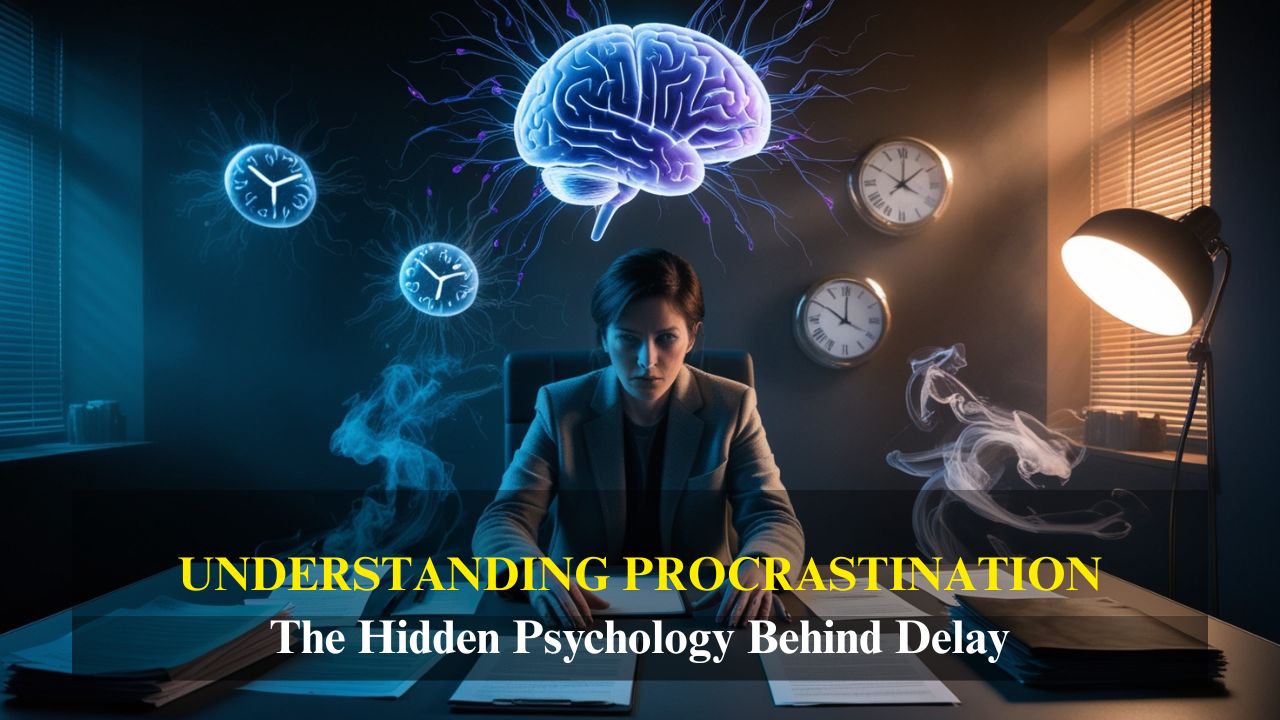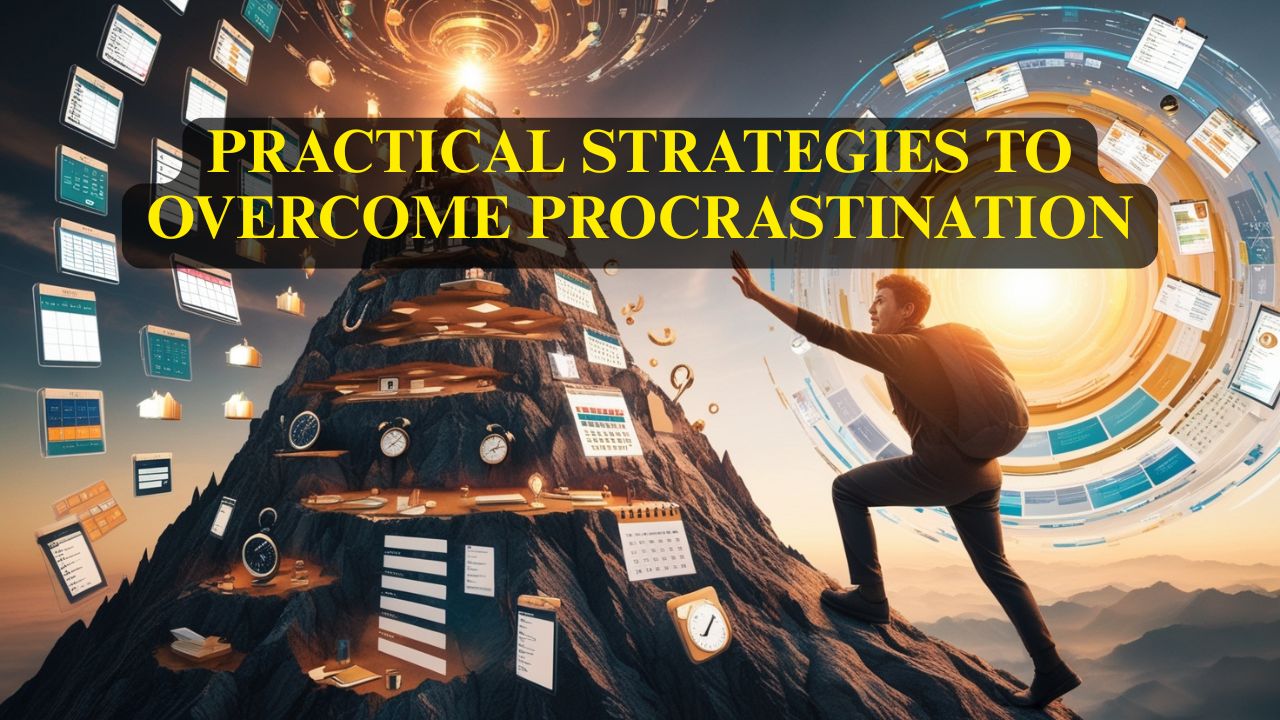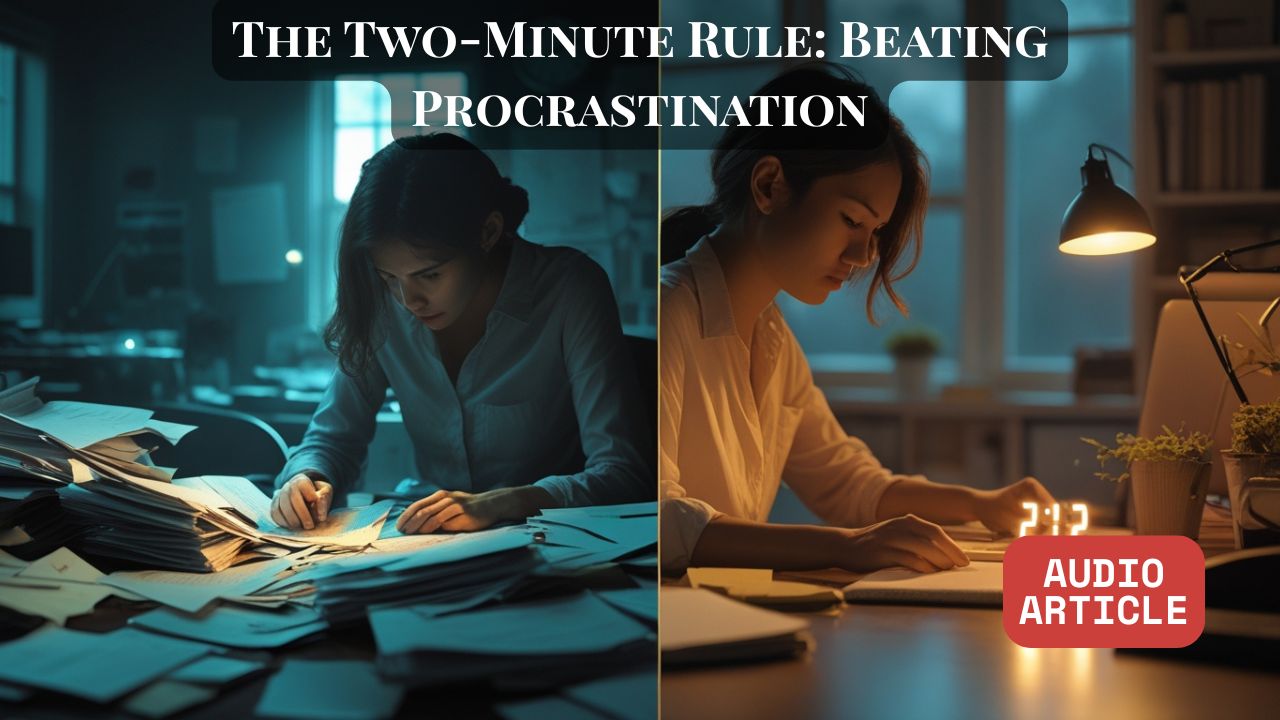The Two-Minute Rule: Beating Procrastination
You know that feeling when you look at your to-do list and immediately feel overwhelmed? There's that important project you've been putting off for weeks, the phone call you need to make but keep avoiding, and the pile of small tasks that somehow feels more daunting than climbing Mount Everest.
So instead of tackling any of it, you find yourself reorganizing your desk, checking social media "just for a minute," or suddenly deciding that now is the perfect time to deep-clean your kitchen. Three hours later, you've accomplished everything except what you actually needed to do, and you're left feeling frustrated and behind.
Welcome to procrastination - that mysterious force that makes us avoid the very things we know we need to do. But here's the thing: procrastination isn't a character flaw or a sign of laziness. It's actually a pretty predictable pattern that you can learn to work with instead of against.
The two-minute rule is one of the simplest and most effective tools for breaking through procrastination. It works by tackling the real root causes of why we avoid tasks in the first place, and it can transform both your productivity and your relationship with getting things done.
Why We Procrastinate (It's Not Laziness)
Before we dive into the solution, let's understand what's really happening when you procrastinate. Most people think procrastination is about being lazy or lacking discipline, but research tells us a very different story.
Procrastination is actually an emotional regulation problem, not a time management problem. When you think about doing a task that feels overwhelming, boring, difficult, or uncertain, your brain perceives it as a threat. Your nervous system activates the same way it would if you were facing physical danger, flooding your body with stress hormones.
Your brain, trying to help you feel better, looks for something - anything - that will provide immediate relief from that uncomfortable feeling. Suddenly, checking your phone, organizing your workspace, or even doing other productive tasks feels much more appealing than the thing you're supposed to be doing.
This is why you can spend hours being incredibly busy and productive while still avoiding the one task that actually matters. Your brain has successfully found ways to feel competent and accomplished while steering you away from the thing that triggers stress.
Let's look at the most common emotional triggers that lead to procrastination:
Overwhelm When a task feels too big or complex, your brain doesn't know where to start, so it chooses not to start at all. You think "I need to organize my entire filing system" or "I have to write this whole report," and the sheer scope of the project triggers avoidance.
Perfectionism If you believe the outcome has to be perfect, the pressure to perform flawlessly can be paralyzing. You think "This has to be amazing" or "I can't afford to mess this up," and suddenly starting feels too risky.
Uncertainty When you're not sure how to do something or what the outcome will be, your brain interprets this as danger. You might avoid making a phone call because you don't know exactly what you'll say, or put off starting a project because you're not sure about the first step.
Boredom Tasks that feel tedious or unstimulating don't trigger your brain's reward system, making them feel like punishment. Your brain naturally seeks more engaging activities to maintain dopamine levels.
Past Negative Experiences If you've had bad experiences with similar tasks before, your brain creates negative associations that trigger avoidance. You might avoid financial planning because dealing with money has been stressful in the past.
Understanding these triggers is crucial because it helps you realize that procrastination is a normal human response to perceived threat or discomfort. You're not broken or lazy - you're just human.
Quick Wins That Build Momentum
The two-minute rule is brilliantly simple: if something takes less than two minutes to do, do it immediately. Don't add it to your to-do list, don't schedule it for later, don't think about it - just do it right now.
This might sound almost too simple to be effective, but it works for several psychological reasons:
It Eliminates Decision Fatigue Every time you look at a task and decide to do it later, you're using mental energy. When you apply the two-minute rule, you eliminate that ongoing decision-making burden. The task gets done and disappears from your mental load entirely.
It Creates Immediate Success Each time you complete a two-minute task, you get a small hit of accomplishment and dopamine. These micro-successes build confidence and momentum, making it easier to tackle bigger challenges.
It Prevents Small Tasks from Becoming Big Problems That email you don't send today becomes an awkward follow-up next week. The bill you don't file becomes a missing document when you need it. The two-minute rule prevents small tasks from growing into larger, more stressful problems.
It Builds a Bias Toward Action The more you practice doing things immediately when they're small, the more you develop a default mode of taking action rather than avoiding. This mental shift affects how you approach all tasks, not just the two-minute ones.
Here are some examples of two-minute tasks you might be putting off:
- Sending a quick text or email
- Filing a document
- Washing a few dishes
- Making a brief phone call
- Updating a calendar entry
- Putting something back where it belongs
- Writing down an idea or task
- Paying a bill online
- Confirming an appointment
The key is being honest about timing. If responding to an email will actually take you fifteen minutes because you need to research something, don't force it into the two-minute rule. But if it's truly a quick response, do it now.
Breaking Big Tasks into Manageable Pieces
The two-minute rule becomes even more powerful when you apply its logic to larger projects. Most procrastination happens because tasks feel too big to start, but every big task is made up of smaller actions, many of which can be done in two minutes or less.
Instead of "organize my entire office," you might have:
- Clear papers off desk (2 minutes)
- File documents in one folder (2 minutes)
- Put books back on shelf (2 minutes)
- Throw away obvious trash (2 minutes)
Instead of "plan my vacation," you might break it down to:
- Open travel website (2 minutes)
- Write down possible destinations (2 minutes)
- Check one flight price (2 minutes)
- Ask friend for hotel recommendation (2 minutes)
The magic happens when you focus only on the next smallest step, not the entire project. Your brain can handle "open travel website" much better than "plan entire vacation." Once you complete that first two-minute action, you often find that continuing feels easier than stopping.
This approach works because it addresses the overwhelm trigger directly. When you break tasks down small enough, they stop feeling threatening and start feeling manageable.
The "Next Physical Action" Technique For any project you're avoiding, ask yourself: "What's the very next physical action I need to take?" Not the outcome you want or the goal you're trying to achieve, but the specific, concrete action.
If you need to "improve your health," the next physical action might be "Google local gyms" or "call doctor's office to schedule appointment." If you want to "be more organized," it might be "pick up papers on dining room table."
Make the action so small and specific that your brain can't find a reason to avoid it. You're not committing to solving the whole problem - just to taking one tiny step forward.
When Perfectionism Becomes the Enemy
Perfectionism is one of the biggest barriers to getting started, and the two-minute rule is a powerful antidote because it prioritizes action over outcome. When you only have two minutes, you can't make something perfect - you can only make progress.
This is actually a feature, not a bug. Perfectionism tricks you into thinking that the planning, preparation, and perfect conditions are more important than actually doing the work. The two-minute rule forces you to engage with reality instead of the ideal.
Good Enough is Better Than Perfect A two-minute email that gets sent is infinitely better than the perfect email that never gets written. A quick phone call that resolves an issue is better than the perfectly scripted conversation you never have. A rough draft that exists is better than the masterpiece that stays in your head.
The two-minute rule teaches you to value completion over perfection, which is a skill that serves you well beyond small tasks. When you get comfortable with "good enough" for small things, you develop the ability to ship work, make decisions, and move forward even when conditions aren't perfect.
Iteration Over Perfection Instead of trying to get things right the first time, focus on getting them started. You can always improve something that exists, but you can't improve something that never gets created.
If you need to write a proposal, don't aim to write the perfect proposal in two minutes. Instead, aim to write the first terrible paragraph, create a rough outline, or even just open the document and write the title. Once you have something to work with, improvement becomes much easier than creation.
The 80/20 Rule Applied Often, 80% of the value comes from 20% of the effort. That quick two-minute action might not solve the entire problem, but it often addresses the most important part or removes the biggest barrier to progress.
Sending a brief email might not be as thorough as the longer one you were planning, but it often communicates everything that really matters. A quick conversation might not cover every detail, but it can resolve the main issue and move things forward.
Building Your Two-Minute System
To make the two-minute rule work consistently, you need to build it into your regular routines and thinking patterns. Here's how to create a system that actually sticks:
The Immediate Decision Framework Whenever you encounter a task, ask yourself: "Can this be done in two minutes or less?" If yes, do it immediately. If no, either break it down into two-minute pieces or schedule it for later.
This decision framework needs to become automatic. At first, you'll need to consciously remind yourself to apply it, but eventually it becomes a natural part of how you process tasks and information.
Daily Two-Minute Sweeps Set aside specific times during the day for handling two-minute tasks. This might be first thing in the morning, right after lunch, or at the end of your workday. During these sweeps, go through your environment and knock out any quick tasks you notice.
Check your email for messages that can be handled quickly. Look around your workspace for items that need to be put away. Review your to-do list for small tasks that have been lingering. These regular sweeps prevent two-minute tasks from accumulating into overwhelming piles.
The Two-Minute Capture System Keep a running list of two-minute tasks so you can batch them together when you have a few minutes available. This might be a note on your phone, a section of your to-do list, or a dedicated notebook.
When you notice something that needs to be done but can't do it immediately, capture it in your two-minute list. Then, when you have a few minutes between meetings or activities, you can quickly knock out several items.
Environmental Cues Set up your environment to make two-minute actions obvious and easy. Keep filing supplies accessible so you can file things immediately. Have cleaning supplies in multiple locations so you can quickly tidy up. Keep thank-you cards and stamps handy so you can send quick notes of appreciation.
The easier you make it to take quick action, the more likely you are to follow through. Remove as much friction as possible from your two-minute tasks.
Expanding Beyond Two Minutes
Once you've mastered the basic two-minute rule, you can expand the concept to build momentum on larger projects:
The Five-Minute Start For bigger tasks you're avoiding, commit to working on them for just five minutes. Set a timer and give yourself permission to stop after five minutes if you want to. Often, you'll find that starting is the hardest part, and once you're engaged, continuing feels natural.
The One-Task Rule Instead of trying to multitask, focus completely on one thing at a time. Even if it takes longer than two minutes, give it your full attention until it's complete. This builds the mental muscle of sustained focus and completion.
The Daily Three Each morning, identify three important tasks you want to complete that day. Apply the two-minute rule to break them down into manageable steps, then focus on making progress on these three priorities before moving to other activities.
The Weekly Review Spend a few minutes each week reviewing what you accomplished and what got left undone. Look for patterns in your procrastination and opportunities to apply the two-minute rule more effectively.
Overcoming Common Obstacles
Even with the two-minute rule, you might encounter some challenges. Here's how to handle the most common ones:
"I Don't Have Two Minutes" If you truly don't have two minutes, you're probably over-scheduled and need to look at your time management more broadly. But most of the time, we do have two minutes - we just spend them on low-value activities like checking social media or staring into space.
Try tracking your time for a day to see where small pockets of time actually exist. You'll likely find multiple two-minute windows that you can redirect toward meaningful tasks.
"I Keep Forgetting" Building any new habit takes time and repetition. Use environmental cues, phone reminders, or habit stacking to help you remember to apply the two-minute rule. Attach it to existing routines: "After I check my email, I'll apply the two-minute rule to anything I can handle quickly."
"It Doesn't Feel Important" Small tasks might not feel significant individually, but their cumulative impact is enormous. A clean workspace, responded-to emails, and handled minor issues create a sense of control and competence that supports your ability to tackle bigger challenges.
"I Get Distracted by Other Things" If you start a two-minute task and find yourself doing something else entirely, practice bringing your attention back to the original task. This builds your focus muscle and helps you complete what you start.
The Ripple Effects
The two-minute rule does more than just help you get small tasks done - it creates positive ripple effects throughout your life:
Reduced Mental Load When you handle things immediately instead of letting them pile up mentally, you free up cognitive resources for more important thinking. Your mind becomes clearer and less cluttered.
Increased Confidence Regular completion of tasks, even small ones, builds a sense of competence and control. You start to see yourself as someone who gets things done rather than someone who procrastinates.
Better Relationships When you respond to messages promptly, keep commitments, and handle small requests quickly, other people see you as reliable and considerate. This strengthens your relationships both personally and professionally.
Reduced Stress Procrastination creates ongoing background stress as undone tasks nag at your consciousness. The two-minute rule eliminates this stress by clearing tasks before they become problems.
Momentum Building Action creates more action. The more you practice taking immediate action on small things, the easier it becomes to take action on bigger things too.
Remember: Progress Over Perfection
The goal isn't to become someone who never procrastinates - it's to become someone who procrastinates less and recovers more quickly when you do get stuck. The two-minute rule isn't a magic cure for all avoidance, but it's a practical tool that makes procrastination less frequent and less problematic.
Some days you'll apply the rule consistently and feel amazingly productive. Other days you'll forget about it entirely and find yourself back in old patterns. Both are normal parts of building a new habit.
Be patient with yourself as you develop this new approach. Every time you choose action over avoidance, even for just two minutes, you're building the mental muscles that support productivity and well-being.
The beauty of the two-minute rule is its simplicity. You don't need special apps, complex systems, or perfect conditions. You just need two minutes and the willingness to start. And starting, as it turns out, is the hardest and most important part of getting anything done.
Your future self will thank you for every two-minute action you take today. Small consistent actions compound into significant results over time, and the two-minute rule is one of the most reliable ways to make that compound growth happen in your own life.






